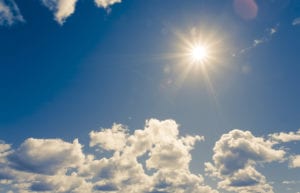Written by Jessica Patella, ND. This cell study demonstrated that the antioxidant properties of crocin, a constituent of saffron, protected the skin from ultraviolet light (UVB)-induced photo-aging.
 Ultraviolet radiation is one of the largest contributors to skin photoaging, which causes the skin to loose elasticity, become wrinkled and have a leathery appearance 1,2. Specifically ultraviolet B radiation (UVB) causes reactive oxygen species (ROS) which age the skin. Research is investigating if supplementing with anti-oxidants can address the ROS and therefore reduce aging of the skin 3. Crocin, a known anti-oxidant, was used at the cellular level and preliminary results demonstrated positive effects in reducing UVB-induced cell damage 1.
Ultraviolet radiation is one of the largest contributors to skin photoaging, which causes the skin to loose elasticity, become wrinkled and have a leathery appearance 1,2. Specifically ultraviolet B radiation (UVB) causes reactive oxygen species (ROS) which age the skin. Research is investigating if supplementing with anti-oxidants can address the ROS and therefore reduce aging of the skin 3. Crocin, a known anti-oxidant, was used at the cellular level and preliminary results demonstrated positive effects in reducing UVB-induced cell damage 1.
There are three categories of ultraviolet radiation, UVA (320-400nm), UVB (290-320 nm) and UVC (200-290 nm). UVB radiation is associated with skin photo aging because it can create ROS that damage the dermal cells, which is why it was used in the study to damage the cells 1.
Saffron is a culinary spice that has been used in China and the Middle East traditionally with food and as a medicine 4. Crocin is one of the main and active constituents isolated from saffron and has been shown in research to have anti-cancer, anti-inflammatory and anti-oxidant effects 1,5. Due to the anti-oxidant effects, researchers questioned if it would help reduce UVB-induced skin aging 1.
Dermal fibroblast cells were isolated from human skin cell samples and then treated with different concentrations of crocin, with untreated cells serving as a control (0, 12.5, 50, 100 microM). The cells were then exposed to UVB light (0, 25, 50 and 100mJ/cm2) and a dose of 100mJ/cm2 was found to inhibit cell growth and was therefore used as the damaging dose. This was followed by another culture of crocin. Cells were then evaluated for cell-aging rate (via Beta-galactosidase), ROS and collagen type 1 1.
The following results were observed:
- Crocin was found to reduce UVB-induced cell aging.
- Crocin was found to reduce UVB-induced ROS, one of the most important factors of photoaging.
- Crocin was found to increase collagen production.
- All results were statistically significant compared to controls (p<0.05)
Extrinsic skin photo aging is linked to environmental factors, such as smoking, pollution, consuming alcohol and UVB radiation 1. The above results show that crocin protected from UVB-induced cell damage by reducing ROS and increasing collagen production 1. The mechanism of how exactly this occurs stills needs to be further researched. It could be that crocin neutralizes ROS, or that it upregulates expression of antioxidants 1.
In conclusion, this preliminary study demonstrated a positive effect of crocin on UVB exposed skin cells. This study demonstrated that the powerful antioxidant properties of crocin protected against UVB radiation and photoaging of the skin. The next step will be to use these results to lead a study in mice, to further understand the anti-photoaging effects 1.
Source: Deng, Mingwu, Dong Li, Yichen Zhang, Guangdong Zhou, Wei Liu, Yilin Cao, and Wenjie Zhang. “Protective effect of crocin on ultraviolet B‑induced dermal fibroblast photoaging.” Molecular medicine reports 18, no. 2 (2018): 1439-1446.
© This work is licensed under a Creative Commons Attribution-Non Commercial-No Derivatives 4.0 by studying it at the cellular level in petri dishes and preliminary results demonstrated positive effects in reducing International (CC BY-NC-ND 4.0) License.
Click here to read the full text study.
Posted October 8, 2020.
References:
- Deng M, Li D, Zhang Y, et al. Protective effect of crocin on ultraviolet B‑induced dermal fibroblast photoaging. Mol Med Rep. 2018;18(2):1439-1446.
- Gilchrest BA. Photoaging. The Journal of investigative dermatology. 2013;133(E1):E2-6.
- Lee YR, Noh EM, Jeong EY, et al. Cordycepin inhibits UVB-induced matrix metalloproteinase expression by suppressing the NF-kappaB pathway in human dermal fibroblasts. Exp Mol Med. 2009;41(8):548-554.
- Boskabady MH, Farkhondeh T. Antiinflammatory, Antioxidant, and Immunomodulatory Effects of Crocus sativus L. and its Main Constituents. Phytother Res. 2016;30(7):1072-1094.
- Samarghandian S, Azimi-Nezhad M, Borji A, Farkhondeh T. Effect of crocin on aged rat kidney through inhibition of oxidative stress and proinflammatory state. Phytother Res. 2016;30(8):1345-1353.

